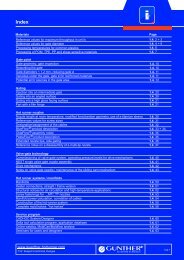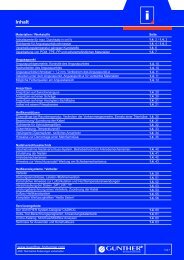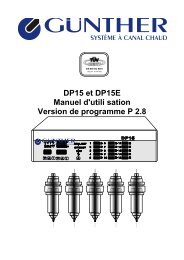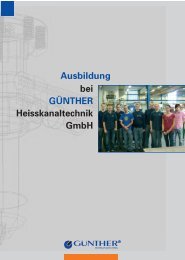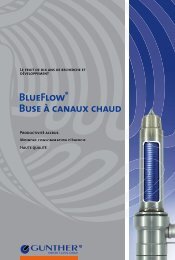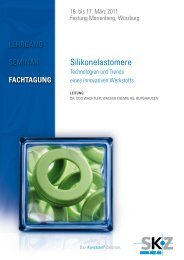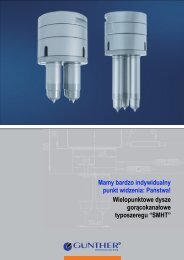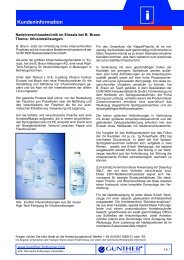Heißkanaldüsen Typ SLT/-DLT Customer information
Heißkanaldüsen Typ SLT/-DLT Customer information
Heißkanaldüsen Typ SLT/-DLT Customer information
Create successful ePaper yourself
Turn your PDF publications into a flip-book with our unique Google optimized e-Paper software.
<strong>Heißkanaldüsen</strong> <strong>Customer</strong> <strong>information</strong><br />
<strong>Typ</strong> <strong>SLT</strong>/-<strong>DLT</strong><br />
Stable and Material Saving Processing of Flame Retardant Polyamides with<br />
GÜNTHER Hot Runner Technology<br />
As a world leading supplier, Moeller GmbH (Bonn) pro-<br />
duces components and systems for automation, command<br />
and control devices. Diverse electrical and electronic<br />
components made of plastic are used in these systems.<br />
Fig. 1 Pushbuttons in command and control equipment<br />
(photo: Moeller GmbH)<br />
For a long time now Moeller has been using molds with<br />
hot runners for sprueless production of these parts. The<br />
advantages of hot runner technology over a conventional<br />
gating system include savings in material and a<br />
reduction in cycle time.<br />
When selecting a plastic for electronic components, it is<br />
often necessary to take account not only of the design<br />
requirements but also of statutory provisions and standards.<br />
In the electronics industry, for example, plastic<br />
components that are in direct contact with live parts must<br />
conform to the IEC Standard (International Electrotechnical<br />
Commission) etc. A further requirement is<br />
that the plastic must be capable of extinguishing itself<br />
after catching fire. Here, Standard 94 of the Underwriters<br />
Laboratories has established itself throughout<br />
the world as the authoritative standard for classifying<br />
flame retardance in plastics. The classification in standard<br />
94 of UL depends on the rate of combustion, time<br />
needed for extinction, formation of drops and afterglow<br />
time. Depending on the component's function, the<br />
following criteria must be met:<br />
UL94 V2: Vertical test specimen; self-extinguishing up<br />
to 30s after withdrawal of the flame, drips of flaming<br />
particles allowed; afterglow max. 60s.<br />
UL94 V0: Vertical test specimen; self-extinguishing up<br />
to 10s after withdrawal of flame; no drips of flaming<br />
particles; afterglow max. 30s.<br />
Moeller usually uses PA66 reinforced with 25% fiber<br />
glass with flame retardant for housing of electrical or<br />
electronic components. This type of material complies<br />
with UL94-V2 combustibility grading as well as other<br />
standards.<br />
A lot of devices from Moeller are also used in areas subject<br />
to the ATEX directives (ATEX = Atmospheres Explosibles<br />
= potentially explosive atmospheres). Here the requirements<br />
set for flammability have recently been<br />
tightened so that these components must now meet the<br />
requirements in combustibility class UL94-V0. On<br />
account of this more stringent requirement Moeller has<br />
had to replace the type of plastic it had previously used in<br />
a lot of components by an appropriate one classified in<br />
conformance with UL94-V0.<br />
Depending on the polymer, various flame protection systems<br />
are necessary to make a plastic flame-retardant. In<br />
the case of the PA66 used here, red phosphorus is used<br />
to give flame retardancy. The combustibility class is<br />
usually influenced by the quantity of the flame protection<br />
system used. Depending on the quantity, the red phosphorus<br />
used here reacts more or less strongly to temperature.<br />
Accordingly overheating during processing can<br />
cause thermal damage to the flame retardant. The gases<br />
arising as a result can form deposits on the mold and lead<br />
to corrosion. Occasionally the gases can even inflame.<br />
The PA66 with 25% glass fibers originally used by<br />
Moeller (combustibility class in conformance with UL94-<br />
V2) could be processed easily with the existing hot<br />
runner system. However, after changing to a PA66-GF25<br />
conforming to combustibility class UL-V0, serious problems<br />
arose when processing with this hot-runner system.<br />
In spite of the processing temperatures of 275…295°C<br />
being appropriate for the material, extremely severe deposits<br />
appeared on the molds. The molds had to be<br />
cleaned every 30,000 to 35,000 shots. In addition to<br />
cleaning the mould deposits, the mold inserts had to be<br />
replaced after every 250,000 shots because of<br />
corrosion. The reason for this heavy formation of<br />
deposits and corrosion in the mold was the significantly<br />
excessive rise in temperature in the hot runner nozzles in<br />
connection with the higher quantity of red phosphorus in<br />
the PA66. With a temperature of 290°C set at the control<br />
unit, temperatures of approx. 360°C were sometimes<br />
measured in the nozzles. This caused a reaction in the<br />
flame retardant.<br />
For any questions, please contact our Application Engineering department at +49 (0) 6451 5008-31 or -63.<br />
The <strong>information</strong> is given in accordance with our present-day knowledge and is meant to provide technical background.<br />
.<br />
www.guenther-hotrunner.com<br />
7/12 Subject to technical changes<br />
iA<br />
1.5. 7



